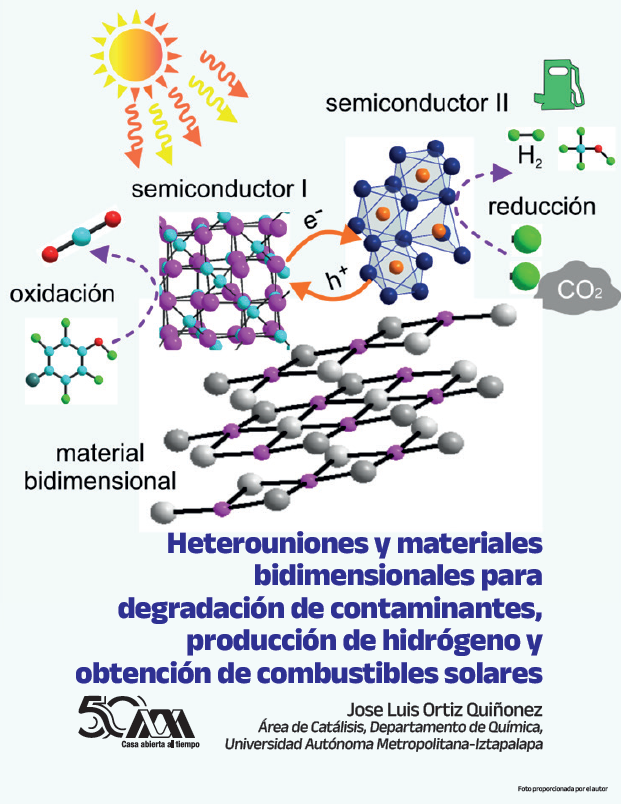Heterouniones y materiales bidimensionales para degradación de contaminantes, producción de hidrógeno y obtención de combustibles solares
Abstract
Heterojunctions typically consist of two semiconductor materials in close contact or one metallic nanostructure in contact with a semiconductor. On the other hand, two-dimensional (2D) materials manifest as sheets with remarkably low thicknesses. Many 2D materials have high electrical conductivity and surface area, along with the potential for functionalization to enhance performance across various applications. This paper elucidates key features, properties, and applications of both heterojunctions and 2D materials. Specifically, it underscores the advantages of these materials in hydrogen production, photodegradation of persistent pollutants, and the generation of small molecules through CO2 photoreduction in the presence of solar irradiation.
Downloads
References
Gogotsi, Y., Anasori, B. The rise of MXenes, ACS Nano. 13, pp. 8491–8494, 2019. https://doi.org/10.1021/acsnano.9b06394.
Gopalakrishnan, D., Damien, D., Shaijumon, M.M. MoS2 Quantum Dot-Interspersed Exfoliated MoS2 Nanosheets, ACS Nano. 8[5], pp. 5297–5303, 2014.
Lim, S., Park, H., Yamamoto, G., Lee, C., Suk, J.W. Measurements of the electrical conductivity of monolayer graphene flakes using conductive atomic force microscopy, Nanomaterials. 11, p. 2575, 2021. https:// doi.org/10.3390/nano11102575.
Marcano, D.C., Kosynkin, D. V., Berlin, J.M., Sinitskii, A., Sun, Z., Slesarev, A., Alemany, L.B., Lu, W., Tour, J.M., Improved synthesis of graphene oxide, ACS Nano. 4, pp. 4806–4814, 2010. https://doi. org/10.1021/nn1006368.
Ong, W.J., Tan, L.L., Ng, Y.H., Yong, S.T., Chai, S.P. Graphitic carbon nitride (g-C2N4)-based photocatalysts for artificial photosynthesis and environmental remediation: Are we a step closer to achieving sustainability?, Chem. Rev. 116[12], pp. 7159–7329, 2016. https://doi. org/10.1021/acs.chemrev.6b00075.
Ortiz-Quiñonez, J. L., Cancino-Gordillo, F.E. Pal, U., Removal of Cr(III) ions from water using magnetically separable graphene-oxide-decorated nickel ferrite nanoparticles, ACS Appl. Nano Mater. 6[19], pp. 18491–18507, 2023. https://doi. org/10.1021/acsanm.3c03618.
Yan, B., Ding, W., Lin, X., Cai, Q., Zhang, S. Selective hydrogenolysis of lignin for phenolic monomers with a focus on β-O- 4 cleavage and C=O hydrodeoxygenation, Fuel. 320, p. 123732, 2022. https://doi.org/ 10.1016/J.FUEL.2022.123732.
Yang, P., Zhang, J., Chen, C. Guo, X., Zhang, J., Zhang, X., Wu, Z. CdTe quantum dot/Bi2WO6 nanosheet photocatalysts with a giant built-in electric field for enhanced removal of persistent organic pollutants, ACS Appl. Nano Mater. 5, pp.5128–5139, 2022. https://doi. org/10.1021/acsanm.2c00155.
Yanilmaz, A., Tomak, A., Akbali, B., Bacaksiz, C. Ozceri, E., Ari, O., Senger, R.T. Selamet, Y., Zareie, H.M. Nitrogen doping for facile and effective modification of graphene surfaces, RSC Adv. 7, pp. 28383– 28392, 2017. https://doi.org/10.1039/ c7ra03046k.






